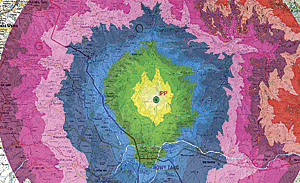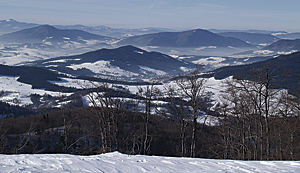Lost and Found in the Polish Carpathian Mountains
GIS-Based Analysis Is Aiding the Search, Rescue, and Safe Return of Lost Hikers
By Elzbieta Filipkowska, with Robert J. Koester, Rafal Chrustek, and Mariusz Zaród
Highlights
- Search and rescue are managed with ArcGIS and integrated navigation and communication solutions.
- ArcGIS for Server helps determine exploratory areas and routes and publish them to PDAs.
- With GIS, rescuers conduct statistical analysis to determine the likelihood of finding missing persons in specific locations.
The Search and Rescue Mountain Team for the Polish mountains consists of seven regional groups. The work area of one of these groups—the Podhalanska Group (PG)—includes the Outer Western Carpathian Mountains (Gorce, Beskid Wyspowy, Pasmo Polic, Orawy, part of Beskid Sadecki, and Beskid Makowski) and the Central Carpathian Mountains (Pieniny). This area consists of 4,200 square kilometers, with 1,500 kilometers of hiking trails, 50 ski lifts, and peaks rising up to 1,400 meters above mean sea level.
PG unites 360 rescuers, including 33 instructors and 16 professional rescuers. Every year, PG rescuers are involved in about 700 actions, expeditions, and interventions, including dozens of exploratory expeditions. The search and rescue expeditions in the region's mountains, forests, and valleys mainly involve lost hikers, the injured (e.g., forest workers), the elderly, children (6-12 years old), the mentally ill, people with Alzheimer's disease, and suicides.
In Rabka-Zdrój, the spa town in southern Poland where PG's headquarters is located, staff and rescuers perform analysis of both terrain and the behavior of those who are lost (based on psychological profiles) to assist in the selection of search and rescue tactics. Aerial photos and orthophotos; statistics; and information about road networks, watercourses, and land cover and its configuration are analyzed by PG.
PG efforts are managed using ArcGIS software in conjunction with integrated navigation and communication solutions. The implementation of GIS is a result of PG instructors' intense study and development of the command and control system. The choice of ArcGIS software was made based on the recommendation of a PG rescuer (who is a current PhD student with a passion for GIS). The implemented solutions enable rescuers to conduct analyses and use the statistics in real time during operations.
Podhalanska Group's GIS
The stationary command post at Rabka-Zdrój allows PG rescuers to handle GPS data transmitted from the communication module to the database. The data is presented in the system so as to clearly identify the ID device type and its position. Rescuers' positions are mapped as determined by GPS receivers embedded in mobile radios, as well as PDAs, web tracking devices, and mobile command stations.
The GIS enables PG to determine exploratory areas and routes and publish them to PDAs using ArcGIS for Server. In the course of exploration, the rescue commander can monitor the route and the last known location of GPS-equipped mobile devices. It is also possible to check the previous locations for any time interval. This facilitates marking areas that have already been checked. In the case of expeditions that do not require coordination in the field, the action is managed only from the stationary command post.
In addition to the stationary command post, PG has a vehicle-mounted mobile command station. It is fully equipped with a notebook computer loaded with software for monitoring the current position of each GPS device. The position of the PDA is transmitted via the Global System for Mobile Communications (GSM) network to a server system at the headquarters. In addition, the PDAs have software to restore routes or other areas of exploration, perhaps provided by the commander of the rescue operation, in the form of a vector map layer. The current position of rescuers on the GIS map can also be presented so the commander of an operation can observe rescuers' movements within the exploratory area and thus better manage the action. Since the mobile command station is equipped with ArcGIS software, it can be used to perform most of the same activities as the stationary command post (with the exception of 3D analysis). This makes it possible to conduct a rescue action independently.
In addition to communication via the GSM network, the system can handle, on the server-side application, GPS positions from mobile radios.
Moreover, rescue dogs used in areas inaccessible to rescuers are equipped with telemetry collars so rescuers can follow their locations on their mobile devices.
GIS and Search and Rescue Action Planning
The information about the position of rescuers in the exploration area, obtained from GPS receivers, is critical, especially for the commander. An appropriate distribution of rescuers may enhance the accuracy of exploration within the area and increase the likelihood of finding a lost person.
In 2002, PG developed an exploratory method called "fast three." In this method, the rescuers are divided into groups of three, and one of the rescuers in each group is equipped with a GPS device. The advantage of such a setup is primarily to allow rescuers to choose routes to explore in the course of the action, because the rescue team has no delimited route before the exploration.
Statistics in Exploratory Analyses
PG's GIS not only enables exploratory route planning but also allows rescuers to analyze various aspects of a disappearance incident in terms of spatial reference (the analyses can be displayed on the map). The PG database was created based on the International Search & Rescue Incident Database (ISRID), which includes 41 categories of exploration (e.g., hikers, autistics) and more than 50,000 disappearances. The statistics in ISRID are described by Robert J. Koester in Lost Person Behavior. The database used by PG has been adapted to Polish conditions [see "Modeling the Movement of Lost People"].
Summary
Development of GIS technology allowed Podhalanska Group to use a modern system that provides remote monitoring of rescuer positions on a map and assign them jobs and routes within a search area. In addition, the use of the capabilities of Esri ArcGIS software enables Podhalanska Group rescuers to conduct statistical analysis to determine the likelihood of finding the missing person in a specific location.
Data implemented in the GIS, such as layers of roads and drainage, can be used in subsequent actions, which can significantly accelerate the rescue operation and thus increase the likelihood of finding a lost person.
About the Authors
Elzbieta Filipkowska is GIS specialist and a graduate of Geographic Information Management at Cranfield University (United Kingdom) and Environmental Protection at Warsaw University of Life Sciences (Poland). Robert J. Koester is CEO of dbS Productions. Mariusz Zaród is head of Podhalanska Group of Search & Rescue Mountain Team. Rafal Chrustek is a GIS analyst and deputy head of Podhalanska Group.
For more information, contact Elzbieta Filipkowska (e-mail: e.filipkowska@hotmail.com), Robert J. Koester (e-mail: Robert@dbS-sar.com), or Rafal Chrustek (e-mail: rchrustek@gopr-podhale.pl). The Search and Rescue Mountain Team received Esri's Special Achievement in GIS (SAG) Award at the 2012 Esri International User Conference.

